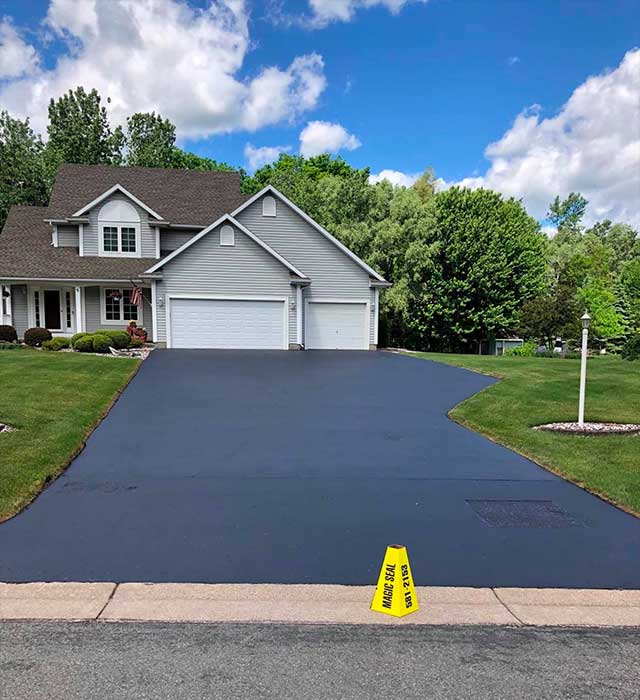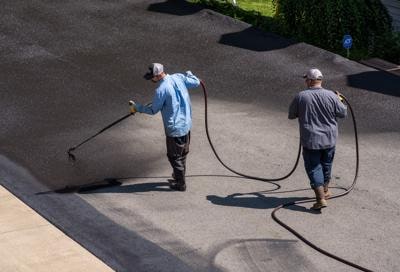Let loose the Possible: Regrading and Asphalt Sealing for Business Areas
Let loose the Possible: Regrading and Asphalt Sealing for Business Areas
Blog Article
Hot Mix Asphalt: A Sustainable Option for Pavement
Hot Mix Asphalt (HMA) has arised as a leading lasting choice for pavement remedies, offering a myriad of ecological benefits and innovative technologies. As the demand for eco-friendly construction practices grows, exploring the subtleties of HMA's sustainability can supply important insights right into the future of pavement options.
Environmental Benefits of Warm Mix Asphalt

Moreover, Hot Mix Asphalt assists to reduce city heat island results. Its dark color absorbs sunlight, reducing the amount of warm mirrored back into the ambience compared to lighter-colored sidewalks. This can lower ambient temperature levels in urban locations, lowering the need for a/c and eventually reducing energy consumption.
Furthermore, Hot Mix Asphalt adds to improved stormwater management. Its permeable nature permits water to recharge and infiltrate the pavement groundwater supplies, reducing runoff and the risk of flooding. These ecological benefits make Hot Mix Asphalt a sustainable choice for leading highways and roads.
Power Performance in HMA Manufacturing
Is energy performance a vital element in the production of Hot Mix Asphalt (HMA)? Definitely. Power plays a significant role in the manufacturing of HMA, influencing both price and environmental sustainability. One crucial facet of power effectiveness in HMA manufacturing is making use of cozy mix asphalt (WMA) modern technologies (angled parking). WMA enables the mixing and placement of asphalt at lower temperature levels contrasted to conventional hot mix asphalt, causing minimized energy intake throughout production. This procedure not only reduces gas usage however also decreases greenhouse gas discharges, making it a more eco pleasant option.
Furthermore, advancements in plant innovations have actually led to even more energy-efficient HMA production procedures. Modern plants are designed with attributes like recycled asphalt pavement (RAP) processing capabilities, efficient burner systems, and boosted insulation, all adding to energy cost savings. By enhancing power usage in HMA production, the industry can decrease its carbon footprint while keeping high-grade pavement materials. Energy performance is, for that reason, an important factor to consider in ensuring the sustainability of Warm Mix Asphalt production.
Recyclability of Hot Mix Asphalt
The recyclability of Hot Mix Asphalt (HMA) is a critical element of its sustainability and lasting environmental influence. HMA is just one of one of the most recycled products in the United States, with over 100 million lots of redeemed asphalt sidewalk (RAP) being reused annually in new sidewalk building and construction. Reusing HMA offers a number of ecological advantages, such as minimizing the need for virgin materials, lowering power intake during production, and lowering the amount of waste sent out to landfills.
The process of recycling HMA involves crushing the existing sidewalk, crushing it into smaller sized items, and mixing it with new accumulation and asphalt binder to produce a recycled mix. In general, the recyclability of HMA plays a significant duty in advertising sustainable practices within the sidewalk industry.

Long-Term Efficiency of HMA
Asphalt sidewalks show resilience and strength over an extended duration, mirroring the lasting performance of Hot Mix Asphalt (HMA) The durability of HMA can be credited to its capability to hold up against rush hour tons, extreme weather problems, and the impacts of aging. Studies have actually revealed that well-designed and properly created HMA sidewalks can last for 20 years or more with routine upkeep. The trick to maximizing the lasting efficiency of HMA hinges on utilizing high-grade products, following finest methods in building and construction, and executing reliable maintenance techniques. Correct drainage, regular examinations, and prompt repairs are important for protecting the architectural stability of HMA sidewalks over time. Additionally, developments in HMA innovation, such as using polymer-modified binders and cozy mix asphalt, have actually additionally improved the longevity and durability of regrading HMA pavements. By prioritizing high quality building and maintenance methods, HMA proceeds to prove itself as a affordable and sustainable service for lasting sidewalk infrastructure.

HMA: Toughness and Sustainability
Showing both resilience and sustainability, Warm Mix Asphalt (HMA) has actually come to be a foundation in the construction of resilient sidewalk facilities - commercial parking lot paving. HMA's resilience comes from its capacity to stand up to hefty lots, extreme climate condition, and high website traffic volumes, making it a trustworthy choice for roads, freeways, and airport runways. The structure of HMA, which normally consists of aggregates, binder, and filler, plays an important role in improving its long life and resistance to tear and wear
Furthermore, HMA's sustainability hinges on its recyclability and energy-efficient production procedure. The capability to recycle reclaimed asphalt pavement (RAP) in brand-new HMA mixtures decreases the demand for virgin materials and minimizes the environmental effect of sidewalk building and construction and upkeep. In addition, the power performance of generating HMA depends on its reduced mixing temperature levels compared to various other sidewalk products, causing reduced power usage and greenhouse gas discharges.
Final Thought
In final thought, warm mix asphalt (HMA) uses a lasting service for sidewalk with its ecologically pleasant qualities. HMA's recyclability, power effectiveness in production, and long-lasting longevity make it an environment-friendly choice for roadway construction.
HMA is one of the most recycled materials in the United States, with over 100 million lots of redeemed asphalt pavement (RAP) being reused annually in brand-new pavement building.The process of reusing HMA includes crushing the existing pavement, squashing it into smaller sized pieces, and mixing it with new accumulation and asphalt binder to produce a recycled mix.Asphalt pavements show resilience and strength over an extended duration, reflecting the long-lasting efficiency of Hot Mix Asphalt (HMA) Furthermore, innovations in HMA technology, such as the usage of polymer-modified binders and cozy mix asphalt, have actually additionally improved the toughness and longevity of HMA pavements. The capability to recycle redeemed asphalt sidewalk (RAP) in new HMA mixes decreases the demand for virgin products and minimizes the environmental influence of sidewalk construction and upkeep.
Report this page